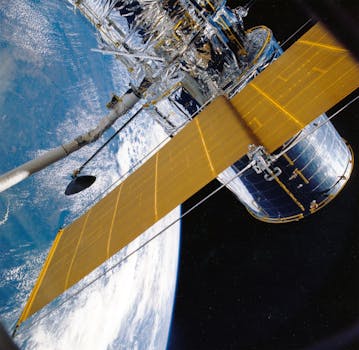From Ground to Sky: The Evolution of Satellite Telecommunications Technology

From Ground to Sky: The Evolution of Satellite Telecommunications Technology Satellite Telecommunications has undergone significant transformations since its inception, revolutionizing the way we communicate and access information. The evolution of satellite telecommunications technology has been a remarkable journey, from the launch of the first commercial communications satellite, Intelsat 1, in 1965, to the current era of high-throughput satellites and advanced telecommunications systems.
The early days of satellite telecommunications were marked by limited bandwidth and high costs, making it accessible only to a select few. However, with advancements in technology and the launch of new satellite constellations, the cost of satellite communications decreased, and its availability increased. The introduction of geostationary satellites, which remain stationary in the sky, enabled the transmission of signals over long distances, further expanding the reach of satellite telecommunications.
The 1980s saw the introduction of mobile satellite communications, which enabled individuals to stay connected while on the move. This was followed by the launch of the first global satellite phone network, Iridium, in 1998. Although the project faced significant challenges, it paved the way for future developments in mobile satellite communications. The launch of the Globalstar constellation in 2000 and the introduction of broadband satellite services marked a significant milestone in the evolution of satellite telecommunications.
In recent years, the advent of high-throughput satellites (HTS) has revolutionized the satellite telecommunications industry. HTS satellites offer significantly higher bandwidth and faster data transfer rates, making them ideal for applications such as broadband internet, video streaming, and mobile networks. The launch of HTS constellations, such as Intelsat’s EpicNG and Viasat’s ViaSat-2, has further expanded the capabilities of satellite telecommunications.
The current state of satellite telecommunications is characterized by the increasing use of advanced technologies, such as satellite-based internet of things (IoT) and 5G networks. The integration of satellite communications with terrestrial networks has enabled the creation of hybrid networks, which offer seamless connectivity and ubiquitous coverage. The growing demand for satellite-based services, particularly in the maritime and aeronautical sectors, has driven the development of specialized satellite constellations, such as Iridium’s Certus and Inmarsat’s Global Xpress.
The future of satellite telecommunications holds much promise, with several upcoming developments expected to shape the industry. The launch of new satellite constellations, such as OneWeb and Amazon’s Kuiper Systems, is expected to increase competition and drive innovation. The integration of satellite communications with emerging technologies, such as artificial intelligence and blockchain, is likely to create new opportunities and applications. As the demand for satellite-based services continues to grow, the evolution of satellite telecommunications technology will remain a critical component of the global telecommunications landscape.
Another significant trend in the satellite telecommunications industry is the increasing use of small satellites, also known as smallsats. Smallsats are smaller and less expensive than traditional satellites, making them an attractive option for startups and companies looking to enter the market. The use of smallsats has enabled the development of new applications, such as Earth observation and satellite-based IoT. The launch of smallsat constellations, such as Planet Labs’ Dove and Spire’s Lemur, has demonstrated the potential of smallsats to provide high-resolution imagery and weather data.
In conclusion, the evolution of satellite telecommunications technology has been a remarkable journey, marked by significant advancements and innovations. From the early days of limited bandwidth and high costs to the current era of high-throughput satellites and advanced telecommunications systems, satellite telecommunications has transformed the way we communicate and access information. As the industry continues to grow and evolve, it is likely to play an increasingly important role in shaping the global telecommunications landscape.
History of Satellite Telecommunications
The history of satellite telecommunications dates back to the 1960s, when the first commercial communications satellite, Intelsat 1, was launched. This was followed by the launch of the first geostationary satellite, Syncom 2, in 1963. The 1970s saw the introduction of domestic satellite systems, such as the United States’ ATS-6 and Canada’s Anik A1. The 1980s witnessed the launch of the first mobile satellite communications systems, including the International Maritime Satellite Organization (Inmarsat) and the first global satellite phone network, Iridium.
Current State of Satellite Telecommunications
The current state of satellite telecommunications is characterized by the increasing use of advanced technologies, such as satellite-based IoT and 5G networks. The integration of satellite communications with terrestrial networks has enabled the creation of hybrid networks, which offer seamless connectivity and ubiquitous coverage. The growing demand for satellite-based services, particularly in the maritime and aeronautical sectors, has driven the development of specialized satellite constellations, such as Iridium’s Certus and Inmarsat’s Global Xpress.
Future of Satellite Telecommunications
The future of satellite telecommunications holds much promise, with several upcoming developments expected to shape the industry. The launch of new satellite constellations, such as OneWeb and Amazon’s Kuiper Systems, is expected to increase competition and drive innovation. The integration of satellite communications with emerging technologies, such as artificial intelligence and blockchain, is likely to create new opportunities and applications. As the demand for satellite-based services continues to grow, the evolution of satellite telecommunications technology will remain a critical component of the global telecommunications landscape.




